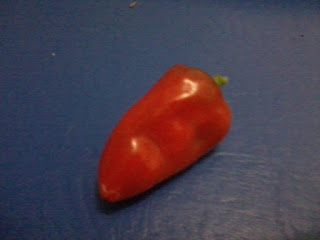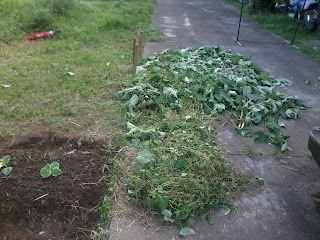Tuesday, November 27, 2012
Tuesday, November 20, 2012
Friday, November 9, 2012
Improvised Mini Net Houses
 |
| I planted eggplant, squash, tomato, and sitao this morning and laid the pots on a plot I have been working on with organic material for a month. |
 |
| Here's a view of my mini net houses together with the other experimental plots and my neighbor's plots. |
Wednesday, November 7, 2012
Yellow Sticky Trap Experiment
 |
| Here's my version of a yellow sticky trap that I placed near my bell pepper plants |
From Module 6 Organic Pest Management
* "Yellow sticky traps are effective in controlling aphids and leaf miners as these insects are attracted to the yellow color. They work in the same way as fly paper. Yellow sticky traps can be bought from garden supply shops or can be improvised. Yellow plastic plates or bottles can be smeared with grease where the insect pests will stick and be immobilized."
When I read Module 6, I googled the names of the weeds and saw pictures of them. I realized that I have a lot of them in my yard. Now I know that the amaranth and kulitis are beneficial to the organic system.
* "The common weed, spiny amaranth or “uray”
(Amaranthus spinosus) and kulitis (A. viridis) should not be weeded out
but instead allowed to grow in the vegetable farm. Amaranthus serve as
refuge of the beneficial flower bug, Orius tantillus.
This
bug is an efficient predator of thrips. It also eats the eggs and
larvae of pest butterflies and moths (called lepidopterans). Thus it is
useful to maintain Amaranthus along borders or within vegetable farms in
order to provide a continuous sanctuary for the Orius predators."
 |
| Kulitis (from Google Images) |
 |
| Uray (from Google Images) |
Here are other excerpts from the module that I found interesting and I might try in my garden (I posted these on Facebook as status updates so that I would remember and also for my friends to know:
* "The increase in yield lasted for more than
one season implying that use of marigolds in nematode management in
tomato has good potentials" (Ploeg 2002). "The key mode by which
marigolds suppress plant-parasitic nematodes is through a biochemical
interaction known as allelopathy. Allelopathy is a phenomenon where a
plant releases compounds that are toxic to other plants, microorganisms,
or other organisms, such as nematodes" (Ploeg et al, n.d.).
* "Corn is also used as trap crop or sacrificial
plant in vegetable growing areas. It attracts insect pests thus draws
the insect pests to it and away from the vegetable crops. Meanwhile,
beneficial insects also stay on the corn plant and wait for the insect
pests that they prey on."
Monday, November 5, 2012
Sorta Community Vegetable Garden Phase 1
Subscribe to:
Comments (Atom)
Glinoga Integrated Farm: Initial Visit to Pitogo, Quezon for DOST-funded "Women-Led Permaculture" Project
Memorandum of Understanding (MOU) signing with Ms. Nenieveh "Weng" Glinoga of Glinoga Integrated Farm, our partner permaculture ...

-
Presented here is a map of the 12 permaculture sites we studied for our research. We hope to document and study more sites soon, if ev...
-
Aerial photo of Umaleng Organic Farm. Photo by Dada Mercado. Dumingag is a small town in Zamboanga del Sur. It's the lone permacult...
-
Focus group discussion with members of the Layog clan. Photo by Michael Reyes, Jr. Our last destination for our permaculture journey i...

















































